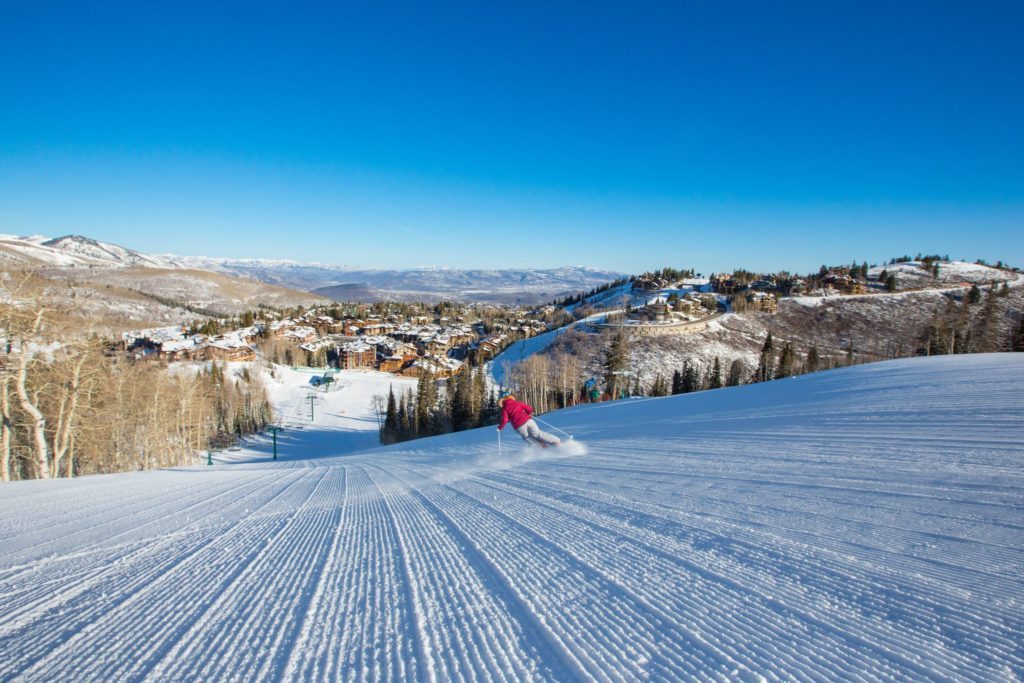How big are your wheels?
If you are a mountain biker or know someone who is, you may have heard the debate raging on about mountain bike wheel diameters. From 26 to 27.5 and all the way to 29-inch, there seems to be little consensus. To attempt to sort out what the ideal wheel dimension is, I recently sat down with Chris Erkkila, assistant mountain biking manager and Doug Gormley, lead bike instructor at Deer Valley Resort.
JF: Sometimes I wonder if I have the right size wheels on my mountain bike and if I am not giving away performance by staying on traditional 26-inch tires?
Chris Erkkila: It’s been a steady progression. In the old days, I’ve saw downhill bikes with a 24-inch wheel in the back and a 26-inch wheel in the front. And then, a few years ago, the 29-inch craze hit so big that the bulk of our rental bikes were all 29-inch wheels! Now, with the 27.5-inch design gaining acceptance, the pendulum has swung back to a position that manufacturers are finding to be a right size that covers everything.
Doug Gormley: Just like Chris, I’ve experienced all wheel sizes, from 26, to 27.5 and 29-inch. There’s no “holy grail” though. All these sizes have strengths and weaknesses. A very simplified argument for the 27.5 is that it “splits the difference.” It falls somewhere in the middle, albeit not quite exactly…
JF: What’s the most obvious benefit of a large, 29-inch wheel?
Chris Erkkila: The theory is that the larger the diameter, the more efficiently it rolls; that’s right, rolling gets easier with bigger wheels. This is the reason why the settlers in the west put large wheels on their wagons; it was much easier for them to go over ruts, wood stumps and rocks.
JF: What was your experience with last year’s rental fleet and its 29-inch wheels?
Doug Gormley: Overall, it worked out really well. There were some issues with some of our smaller riders feeling a bit awkward on the bike. One of the positives was that a 29er rolls over rough terrain very well. For somebody who is struggling to maintain momentum, these wheels can roll over features that would normally hang them up. Another advantage is that this larger wheel provides more traction and also brakes more effectively.
JF: Any downside to a 29-inch wheel?
Chris Erkkila: Well, going downhill gets you more centrifugal force with 29-inch tires, which causes the larger wheel to resist turning. Another possible drawback is that larger wheels create a longer wheelbase that makes turning in tight corners a little bit more challenging.
Doug Gormley: I agree; they are not as maneuverable. I do think there are some people who thought the bike felt a bit cumbersome and awkward at times. This is why our rental fleet will mostly be 27.5 this summer.
JF: But, I’ve also heard that larger wheels make it less likely that the rider will fly over the handlebar; is this true?
Chris Erkkila: Ha, ha! I think the chances are really still there. Maybe just because they can roll over stuff more smoothly, you might be less prone to do it, but if you aren’t very gentle with the new, powerful, hydraulic disk brakes in front, you might still go over the handlebars!
JF: I still don’t understand which wheel performs better for downhill versus cross-country use?
Doug Gormley: Downhill riders need smaller size wheels for nimbleness and maneuverability. Today, in World Cup competition, most riders are still on 26-inch wheels, but more and more are moving to the new 27.5.
Chris Erkkila: You won’t see downhill racers riding a 29-inch, because, as Doug said, it’s less maneuverable; but he’s right, they are leaving their 26-inch for these new 27.5-inch wheels.
JF: So, are you suggesting that 27.5-inch might be a happy medium?
Chris Erkkila: From what I understand, the trend began in Europe with the “650B,” as they call the 27.5-inch over there. It was actually borrowed from road bikes, then adapted to mountain bikes and from that point forward, it was enthusiastically adopted and caught on rather quickly.
JF: Is there a reason for a holy war to settle the perfect wheel size?
Doug Gormley: No, there are so many factors to consider that each size can be fully justified. If you’re into cross-country, 29 might be the obvious choice, but if downhill is your thing, a smaller wheel will work better. I still feel very strongly that there is no panacea, though.
JF: Have the junior riders been spared that tug of war?
Doug Gormley: If anything, there are many junior bikes that benefit from a 24-inch wheel. There are lots of factors like clearance over the top tube, rider’s weight and height that come into play in that category. There are still lots of benefits to 20, 24 an even 26-inch wheels for youngsters.
JF: Are these new 27.5-inch wheels adapted to women’s bike frames?
Chris Erkkila: When the first 29er came out, companies scrambled to place these larger wheels on existing frames, with obviously less success on women’s frames. It wasn’t always a good match. Today, with the growing popularity of 27.5-inch wheels, manufacturers have been adjusting their frame design and construction to work better with that diameter.
JF: As every ounce seems to count enormously, how is wheel design impacted by the quest for weight reduction at all cost?
Chris Erkkila: It was pretty rare to see “everything carbon fiber” 10 to 15 years ago. This has changed and today you’ll see frames and rims made of that material. A larger wheel is heavier and light weight materials become more attractive. Carbon fiber is one of these materials, extremely light and strong but less sturdy than aluminum. If you crash and your bike goes flying off the trail and you damage the carbon fiber, it’s pretty catastrophic. You can put a dent in an aluminum frame and still ride it to a certain extent and be okay. Today, it’s quite common to see carbon wheel sets matched with carbon bike frames. Because of the rocky nature of some mountain trails, there’s obviously a risk that a close encounter with rocks and other obstacles could severely damage these pricey rims.
JF: Do you feature carbon rims in your rental fleet?
Doug Gormley: No, and it’s essentially a matter of cost. These rims are still very expensive! Sure, they’re very lightweight, strong and super stiff. Sometimes even too stiff!
JF: All these considerations about sizes and materials shouldn’t make us forget the critical element that is the tire. What’s new in this area?
Chris Erkkila: We are seeing more tubeless tires these days, just like the ones you have on your car. Tubeless tires allow you to ride on less pressure and they’re also lighter. To a certain extent they also reduce the chance of getting a flat tire.
JF: Why?
Chris Erkkila: Because you can hit certain obstacles on the trail without getting a pinch-flat or “snake-bite” as some folks call it. This happens when the inner tube gets pinched against the rim and you get two holes in the tube. In theory, running without a tube eliminates this, but you should still pack an extra tube, just in case.
Doug Gormley: Our rental fleet is still running with tubes and tires. On a personal level, I’ve been slow embracing the tubeless trend, because it had not prevented me from getting flats. Even with my best tubeless set up, I still carry a tube as a backup.
JF: Are bikes delivered with tubeless set up?
Chris Erkkila: Not usually, it’s more an after-market option.
JF: Let’s talk about inflation. What tire pressure do you recommend?
Chris Erkkila: Several factors should be considered. One is downhill versus cross country. Others are how much a rider weighs, what type of terrain is involved as well as particular trail conditions. I’m 6 feet tall, I weigh 200 pounds, so I inflate my cross-country bike in the high 30s psi (pounds per square inch). On the other hand, my downhill bike is only inflated at 20 to 25 psi. Typically, the lighter you are, the less air you put in; but when you do that, you might increase traction too much. Conversely, the more air you put in, the less rolling resistance exists.
Doug Gormley: In our rental operation, we’re about at 35 psi with the bikes. In some instances, we go as high as 38. This is the best balance we find between good traction and pinch flat avoidance. Of course, if we see a rash of pinch flats, we can always raise that threshold.
JF: I’ve always been told that, prior to going downhill, it make sense to let some air out; is that right?
Chris Erkkila: Oh, yes. It’s hard though; the biggest mistake people make is to just do it “by feel”; unless you do this very often, you’ll mess up. The only way you’ll know for sure is by using a pressure gauge.
JF: On these big, fat tires, what kind of tire tread works best for Deer Valley’s trails?
Doug Gormley: The manufacturers are all doing a good job at matching tire tread with bike suspensions, dimensions and performance. We’ve selected a trail bike that is the equivalent of an all-mountain ski; it is very versatile and the tread selected for these bikes strikes a nice balance between cross-country and downhill.
Chris Erkkila: Tires are like shoes; you might prefer Nike over Adidas, so it comes down to personal preferences. Of course, here we have dry, dusty soil and our tires are suited for these conditions. When we get a rain day at Deer Valley Resort, we call it a “powder day” because if you get just a little bit of moisture on the trail, it gets “tacky” and you can go a bit faster and carry more speed into the turns; it’s fun!
JF: What an enlightening conversation about wheels! As many riders are headed for Deer Valley Resort and get ready to hit your trails this summer, what last piece of advice do you have for them?
Chris Erkkila: There’s no one right wheel size for any certain type of rider. It’s up to each person to go out and try what seems to work best. The 26-inch size probably isn’t going to be around for much longer. It’s going to be 27.5 and 29-inch for the foreseeable future, with the latter wheel size likely to be preferred by many cross-country riders.
Doug Gormley: Beyond this discussion about wheels, we see a large variety of bikes on the mountain. Ultimately though, a good all-mountain trail bike works best, whether you ride the lifts or just pedal. Having a very versatile bike with a suspension offering four to five inches of travel works very well and allows you to accomplish everything you want in a day while truly enjoying it!











 The Official Blog of Deer Valley Resort
The Official Blog of Deer Valley Resort



Very interesting article with great information!